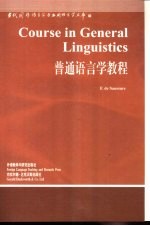图书介绍
普通语言学教程 英文版【2025|PDF下载-Epub版本|mobi电子书|kindle百度云盘下载】

- (瑞士)费尔迪南·德·索绪尔(F.de Saussure)著;(英)Poy Harris译;张绍杰导读 著
- 出版社: 北京:外语教学与研究出版社
- ISBN:7560023746
- 出版时间:2001
- 标注页数:245页
- 文件大小:13MB
- 文件页数:296页
- 主题词:
PDF下载
下载说明
普通语言学教程 英文版PDF格式电子书版下载
下载的文件为RAR压缩包。需要使用解压软件进行解压得到PDF格式图书。建议使用BT下载工具Free Download Manager进行下载,简称FDM(免费,没有广告,支持多平台)。本站资源全部打包为BT种子。所以需要使用专业的BT下载软件进行下载。如BitComet qBittorrent uTorrent等BT下载工具。迅雷目前由于本站不是热门资源。不推荐使用!后期资源热门了。安装了迅雷也可以迅雷进行下载!
(文件页数 要大于 标注页数,上中下等多册电子书除外)
注意:本站所有压缩包均有解压码: 点击下载压缩包解压工具
图书目录
INTRODUCTION1
CHAPTER I. A brief survey of the history of linguistics.1
CHAPTER II. Data and aims of linguistics: connexions with related sciences.6
CHAPTER III. The object of study.8
1.On defining a ianguage8
Preface by Halliday11
2.Linguistic structure: its place among the facts of language11
王宗炎序12
3.Languages and their place in human affairs Semiology15
Preface by Chomsky15
CHAPTER IV. Linguistics of language structure and linguistics of speech18
CHAPTER V. Internal and external elements of a language21
沈家煊序22
1.Why it is necessary to study this topic24
CHAPTER VI. Representation of a language by writing.24
2.The prestige of writing :reasons for its ascendancy over the spoken word24
导读25
3.Systems of writing26
4.Causes of inconsistency between spelling and pronunciation27
5.Consequences of this inconsistency29
CHAPTER VII. Physiological phonetics.32
1.Definition of the subject32
2.Transcription33
3.Writingasas evidence34
APPENDIX PRINCIPPES OF PHYSIOLOGICAL PHONETICS39
CHAPTER I. Sound types.39
1.On defining speech sounds39
2.The vocal apparatus and how it works41
Translator s Introduction41
3.Classification of sounds by oral articulation44
Preface to the First Edition49
1.Necessity of studying sounds in spoken sequences50
CHAPTER II. Sounds in spoken sequences.50
2.Adduction and abduction52
Preface to the Third Edition52
Preface to the Second Edition52
3.Combinations of adduction and abduction in the spoken sequence54
4.Syllabic boundaries and vocalic peaks57
5.Criticism of theories of syllabification58
6.Duration of adduction and abduction59
7.Sounds of aperture 4 Diphthongs Questions of spelling Editorial note62
1.Sign,signification,signal65
CHAPTER I. Nature of the linguistic sign.65
PART ONE GENERAL PRINCIPLES65
2.First principle: the sign is arbitrary67
3.Second principle: linear character of the signal69
CHAPTER II. Invariability and variability of the sign.71
1.Invariability71
2.Variability74
CHAPTER III. Static linguistics and evolutionary linguistics.79
1.Internal duality of all sciences concerned with values79
2.Internal duality and the history of linguistics81
3.Examples of internal duality83
4.Difference between the two orders illustrated by comparisons87
5.Synchronic and diachronic linguistics. Their methods and principles contrasted89
6.Synchronic laws and diachronic laws90
7.Is there a panchronic point of view?94
8.Consequences of the confusion of synchrony with diachrony94
9.Conclusions96
PART TWO SYNCHRONIC LINGUISTICS99
CHAPTER I. General observations.99
1.Entities and units Definitions101
CHAPTER II. Concrete entities of a language.101
2.Methods of delimitation102
3.Practical difficulties of delimitation103
4.Conclusion105
CHAPTER III. Identities, realities, oalues.106
CHAPTER IV. Linguistic value.110
1.The language as thought organised in sound110
2.Linguistic value: conceptual aspects112
3. Linguistic value: material aspects116
4.The sign as a whole118
1.Definitions121
CHAPTER V. Syntagmatic relations and associative relations.121
2.Syntagmatic relations122
3.Associative relations123
1.Syntagmatic interdependences126
2.Simultaneous functioning of both types of group127
1.Their nature and purpose127
3.Absolute arbitrariness and relative arbitrariness130
CHAPTER VIIl. Grammar and its subdivisions.133
1.Definitions. Traditional divisions133
2.Rational divisions135
CHAPTER VIII. Abstract entities in grammar136
CHAPTER VI. The language mechanism.136
PART THREE DIACHRONIC LINGUISTICS139
CHAPTER I. General observations.139
CHAPTER II. Sound changes143
1.Their absolute regularity143
2.Conditioning of sound changes143
3.Methodological considerations145
4.Causes of sound change145
5.The scope of sound change is unpredictable150
1.Breaking grammatical links152
CHAPTER III. Grammatical consequences of phonetic evolution.152
2.Obliteration of word-composition153
3.There are no phonetic doublets154
4.Alternation155
5.Laws of alternation157
6.Alternation and grammatical link159
1.Definition and examples160
CHAPTER IV.Analogy.160
2.Analogies are not changes162
3.Analogy as the creative principle in languages164
CHAPTER V. Analogy and evolution167
1.How an analogical innovation enters the language167
2.Analogical innovations as symptoms of changes in interpretation168
3.Analogy as a principle of renovation and conservation170
CHAPTER VI. Popular etymology.172
CHAPTER VII. Agglutination.175
1.Definition175
2.Agglutination and analogy176
CHAPTER VIII. Diachronic units, identities and realities.178
APPENDICES182
A. Subjective and objective analysis182
B. Subjective analysis and determination of units smaller than the word183
C. Etymology187
PART FOUR GEOGRAPHICAL LINGUISTICS189
CHAPTER I. On the diversity of languages,189
CHAPTER II. Geographical diversity: its complexity.192
1.Coexistence of several languages in the same place192
2.Literary language and local dialect193
CHAPTER III. Causes of geographical diversity.196
1.Time, the essential cause196
2.Linguistic areas affected by time198
3.Dialects have no natural boundaries200
4.Languages have no natural boundaries202
CHAPTER IV. Propagation of linguistic waves.204
1.Force of intercourse and parochialism204
2.A single principle underlying both forces206
3.Linguistic differentiation in separate areas206
PART FIVE QUESTIONS OF RETROSPEOTIVE LINGUISTICS CONCLUSION211
CHAPTER I. The two perspectives of diachronic linguistics.211
CHAPTER II. Earliest languages and prototypes.214
CHAPTER III. Reconstructions.217
2.Degree of certainty of reconstructions219
CHAPTER IV. Linguistic evidence in anthropology and prehistory221
1.Languages and races221
2.Ethnicity222
3.Linguistic paleontology223
4.Linguistic types and group mentality225
CHAPTER V. Language families and linguistic types227
Index231
文件索引237
热门推荐
- 3008434.html
- 567026.html
- 2396428.html
- 832116.html
- 692708.html
- 1530785.html
- 3674950.html
- 3501178.html
- 406049.html
- 3199495.html
- http://www.ickdjs.cc/book_2796697.html
- http://www.ickdjs.cc/book_3365226.html
- http://www.ickdjs.cc/book_3427346.html
- http://www.ickdjs.cc/book_1678197.html
- http://www.ickdjs.cc/book_3834724.html
- http://www.ickdjs.cc/book_883154.html
- http://www.ickdjs.cc/book_234883.html
- http://www.ickdjs.cc/book_2972367.html
- http://www.ickdjs.cc/book_974080.html
- http://www.ickdjs.cc/book_3642832.html